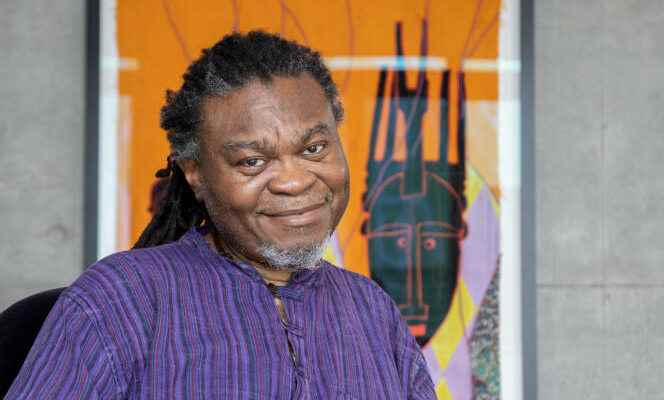To not miss any African news, subscribe to the newsletter of “World Africa” from this link. Every Saturday at 6 a.m., find a week of news and debates covered by the editorial staff of the “World Africa”.
For a long time, Yinka Shonibare only approached Africa in her works, where figures dressed in 18th century costumese century carved in wax illustrate relations with colonial Europe as well as notions of class and privilege. If his work is inhabited by the question of origins, the artist born in 1962 in London took time to reconnect with his Nigerian roots.
It was in 2011, during a conference given at the Lagos Contemporary Art Center, that he suddenly took stock of the cultural appetite of this country where he spent part of his childhood. “I found myself facing a room full of young people, very curious, who wanted to talk about art, but who had few places to see it”he says.
In the process, the star orders a field study. The situation is clear: the galleries that animate the market in Lagos are not platforms for debate. As for the existing museums, they are mainly ethnographic or historical. Yinka Shonibare himself is reserved about the idea of a museum in his name. “It would have required a lot of resources, a qualified team, curators, academics…”details the artist, who inaugurated in early November a place of residence and research called Guest Artists Space (GAS), articulated between Lagos and Ijebu, about a hundred kilometers east of the Nigerian economic capital.
The objective is to welcome each year artists, writers, musicians and scientists in an idea of exchange and sharing of knowledge. No way for these creatives to phosphorize in a vacuum. Yinka Shonibare wanted to double the residence with an ecological farm to introduce communities to sustainable agriculture. Each year, pineapples, plantains, cashews, peppers, cucumbers and tomatoes will be harvested there.
In Ghana, Cameroon
“Access to affordable food should be the basis of every child’s education, as should environmental issues”says Yinka Shonibare, aware of the rampant food insecurity in Nigeria. “It’s a place to develop skills, on a human scale, to learn not to waste and reuse, and also to replant the forest which is vital”adds Belinda Holden, director of GAS.
For this two-headed project to get off the ground, it took time – almost ten years –, energy and above all a lot of money, just over 2 million euros, entirely paid for by Yinka Shonibare. ” But I am counting on patrons for the future, and why not French people he blurts out, half-amused, half-serious.
The artist is not the only one to draw on his own funds to make up for the lack of cultural structures in Africa. Ibrahim Mahama has paid $2.5 million for his three projects combining art and education in his hometown of Tamale, in northern Ghana. “When I have no more moneyhe told us in the summer of 2021, I stop building, and as soon as I have some, I restart the machine. »
The Cameroonian Barthélémy Toguo has devoted 80% of his income to the development for ten years of Bandjoun Station, an artistic project with an agricultural component in the highlands of the Western region. “In Africa, neither politicians nor wealthy businessmen invest in cultureregrets the artist who is divided between France and Cameroon. I cannot sit idly by. What will I do with the money? I don’t need Rolls-Royce. »
A center for the study of African arts
The Louis Vuitton Foundation, which recently published a non-exhaustive list of initiatives launched by artists on the African continent, counts no less than a hundred, including nine in Nigeria. Among the oldest projects is the Market Photo Workshop, an indispensable photography school founded in 1989 by the late South African photographer David Goldblatt, in Johannesburg. “Artists no doubt better understand the shortcomings and needs of artists and want to offer young generations devices to which they themselves did not have access”analyzes curator Ludovic Delalande, who produced this map.
Each initiative responds to a specificity. Tamale, where Ibrahim Mahama has developed three dizzying locations, has benefited little from Ghana’s economic boom. The Bamileke territory, where Barthélémy Toguo opened Bandjoun Station, is isolated from the urban changes experienced by the capital Yaoundé. But nothing is set in stone and the artists allow themselves to develop their project according to changing needs.
Barthélémy Toguo has thus embarked on the creation of a contemporary art museum in Yaoundé, in the heart of the presidency district. Baptized Yakandi Art Center, this space of approximately 1,000 m2, which is scheduled to open in 2025, will house part of the artist’s collection, built up through his exchanges, exhibition spaces, artists’ studios and a library. And above all a center for the study of African arts to host debates and conferences. “I want it to also be a place of education”insists Barthélémy Toguo, recalling that the capital of Cameroon “seriously lacking in professional cultural venues”.
